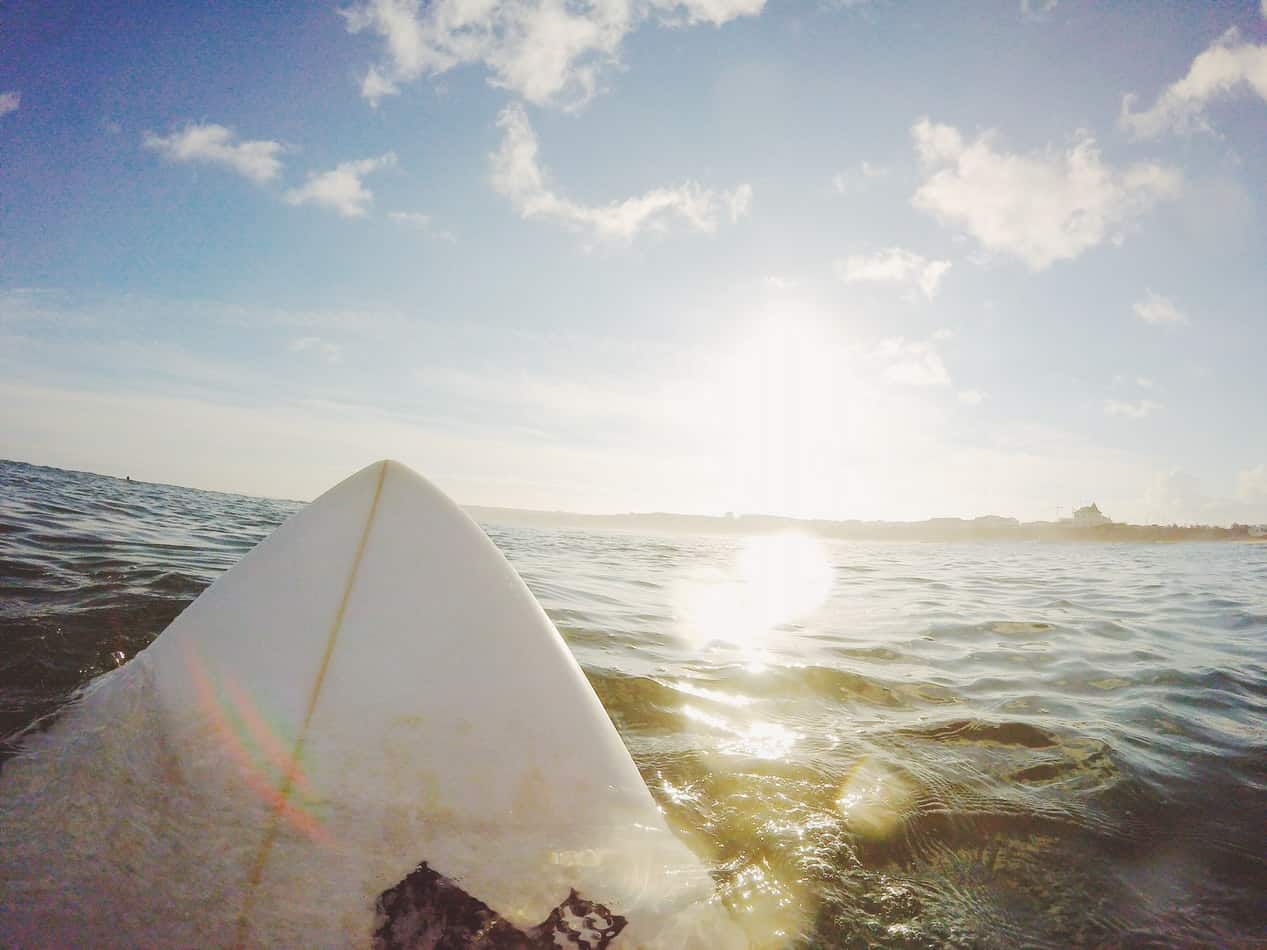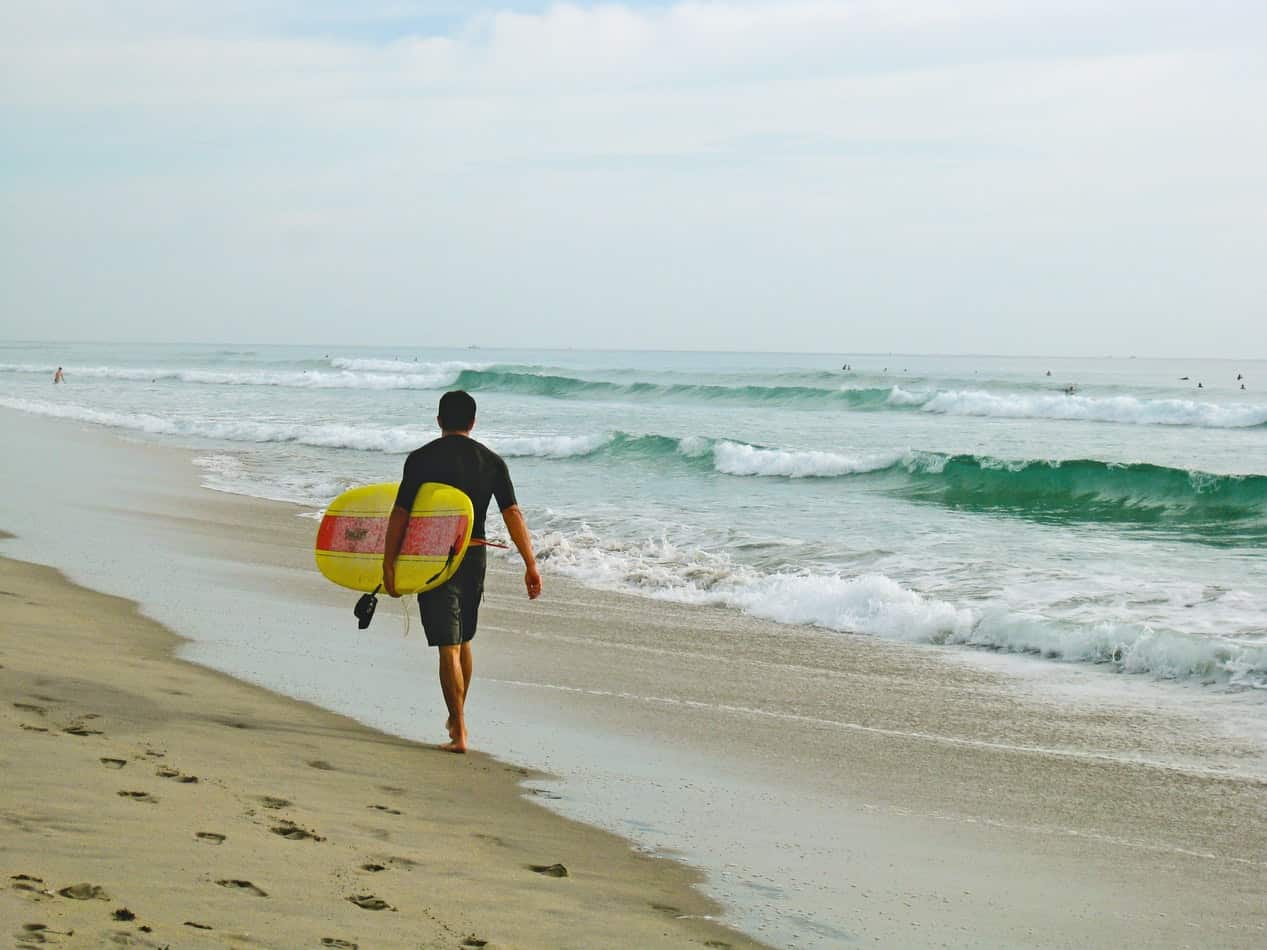If you’ve been riding your surfboard for years, and it’s turned yellow and is a bit delaminated but has no cracks that let water in, you may want to hold onto it. If you’re an advanced surfer, you may feel it loses some of the abilities it had when it was younger. In other words, it loses its “pop.” Besides a little sluggishness on the board, it still does the job it’s meant to do.
But you may ask, how long should your surfboard last? A surfboard that’s been rinsed off after use and has undergone regular checkups and maintenance can last over 10 years. Your continued use of your surfboard year after year depends on how well you’ve taken care of it, where you’ve surfed, and how many dings and cracks it has on it.
Can I Get Away With buying A Used Surfboard?
The answer depends on your experience level and how invested you are in surfing. If you’re not sure if you’re going to surf regularly and just want to try it out, then buying a used board is a great idea.
Used surfboards are much less expensive than a new one. A new board can run $400.00 and higher, but you’ll also need to invest some time maintaining it. Surf wax is not expensive, though, and the wax will last a long time.
However, if you live in a place where it’s sunny a lot, like Southern California or Hawaii, you’ll want to invest in a surfboard bag. A surfboard bag is important because you’ll want to keep the board from being exposed to the sun. A surfboard bag can run from about $30.00 to over $300.00.
So if you’re a beginner who is “testing the waters,” and isn’t 100% committed to surfing, then buying a used surfboard is the right thing to do.
If you’re an experienced surfer but isn’t ready to lay down several hundred dollars for a new longboard, a used board is fine to use in the interim.
When buying a used surfboard, you must inspect the board first. Here are a few things to look for.

- Make sure all the wax has been removed from the surfboard, all the way from the nose to the tail.
Surfboard wax does a great job hiding dings, dents, scrapes, and cracks. Make sure there’s no wax on the board so you can examine it closely. Some surfers put layer upon layer of new wax on their boards without taking off the old wax. All these layers should be scraped off first before anyone sells their surfboard.
Look closely under the nose, made of rubber, and the tail guard for cracks. Surfers who ride in rough terrains, like surfing around piers, or areas where rick jetties jut out into the ocean.
Most important, check for cracks. Water can build up in them and eventually break down the surfboard so it can’t be used.
- Check the leash plug area and the fin boxes.
Look for crack lines in the fiberglass around the leash plug and fin box. Look for salt marks and discoloration (yellowing). Minor cracks on the surface that won’t draw in water aren’t a problem. But if the fin box or plug is any different than the condition it was when new, such as when the plug is pushed in or raised out on the surface, know that you’ll need to replace it. The cost can be anywhere from $50.00 to $75.00.
- Think twice if the surfboard has been spray painted.
Some surfers spray paint their boards to make them look cooler. There’s nothing wrong with spray painting your surfboard. However, paint hides a multitude of sins.
It may be difficult or impossible to inspect a painted surfboard because the paint covers up dings and cracks. If the entire board has been spray painted, you may want to just walk away from the sale. Boards whose entire surface area is painted may be intentional, to hide deep cracks or dents that the owner never took care of.
If you like the spray painted surfboard, though, ask the seller about previous maintenance. It would be great to have some sort of “surf fax” for surfboards like cars now do, which lists the complete service record of previously owned cars. Since surfboards service records usually don’t exist, determine if you can trust what the seller tells you and use your intuition before buying.
What Can I Do To Keep My Surfboard Like New?
If you are an experienced surfer, you will take your board to parts of the ocean where there are point breaks, and where big waves are. Both of these water environments wear down surfboards faster than in places where beginner and intermediate surfers ride.
Experienced surfers who ride often are likely to own a few surfboards instead of only one. They also know how to maintain their boards, so they’ll last a long time. Here are some useful tips.
1. Remove the old wax and put on new wax often.
Surf wax is applied to the surfboard so that you won’t slip off the board when you paddle, pop up, and stand up to ride waves. The wax will melt after a short while and need to be re-applied.
Make sure to always remove old wax from the board before applying new wax. Some surfers simply apply new wax over old wax, and after some time the board will look gray, its white or colored design looking faded. Soon, new wax won’t form the bumps on the board that give you traction when popping up and taking waves standing.
Also, if old wax isn’t’ removed often enough, the cracks and dings on the surfboard will no longer be visible. These cuts and dents need to be repaired as soon as you see them so they don’t get worse and end up breaking down the board until it can’t be used any longer.
Some surfers wax their boards each time they go out and surf. This isn’t necessary if you surf one or two days a week.
Waxing is easy, fast work. One can likely wax a surfboard in less than 30 minutes and be ready for the water. Removing wax is not difficult either. Simply set the board in bright sunlight for about 15 minutes; the sun will do most of the work melting away the old wax.
Then take the board into a cool area away from sunlight and scrape off the old wax with a credit card or some other lightweight straightedge.
When you apply wax to the surfboard, make sure you do it in the shade.
2. Check for dings and cracks every time you’ve surfed.
Fixing bumps, dents, and cracks right away will extend the life of your surfboard. Make sure you own a surfboard tool kit that contains putty and an applicator. Your board will get dings and cracks, so make sure you always examine the board carefully after you use it every time.
3. Don’t leave you surfboard in the sun
The sun’s ultraviolet rays do a number on surfboards. The sun, though far away, acts on polyester fiber found on the deck of surfboards. After a time and with too much sun, a surfboard will begin to yellow, and dull the whites or colors on the board.
Don’t store your board in the sunlight, nor keep it in your car or on the roof of the car when you’re not using it. You’re giving your board a “ skin disease” when you do.
Sore it in a cool, dry place. Do not stand your surfboard against a wall! Instead, store it in a surfboard rack so it’s completely vertical. You can store it horizontally if you wish, as long as the board is level.
Related Questions
How Much Does A Used Surfboard Cost?
The answer depends on the condition of the board when you buy it, and where you buy it from. There are great deals out there. But if you want a board in excellent condition (highly advised), expect to spend anywhere from $150 to $300.00
Are Longboards More Expensive Than Shortboards?
Yes, they are. More material goes into making a longboard. Longboards are between 8 and 12 feet long and are used by most surfers. Beginners start surfing on longboards, and pros who surf big waves in Hawaii, Tahiti, Japan, and Fiji count on longboards to ride 50-foot waves.
You want to get the best-used board you can. However, compare the price of a used longboard to a new one. If the difference is minuscule, you should decide if you want to invest a little more for a new one.
Is There An alternative To Buying A Used Board If I’m Not Sure About Surfing?
You can rent a board and take it to your surf lesson and see if surfing is for you. Most people fall in love with surfing. It’s not just the feeling you get riding a wave, it’s being in the ocean, off of the land, where your perspective changes and your outlook is more positive.

